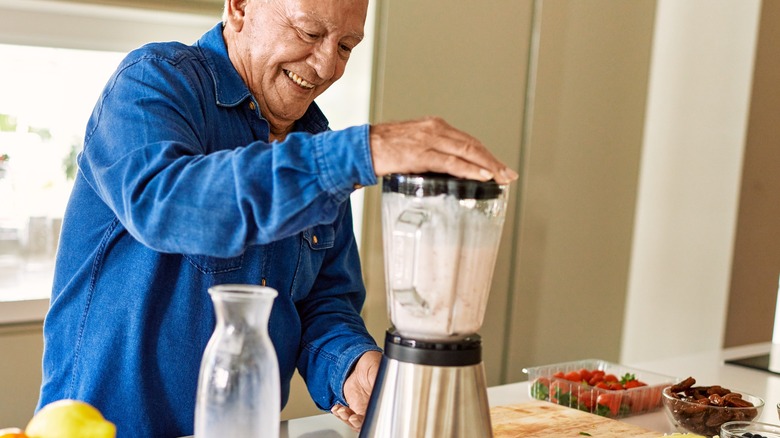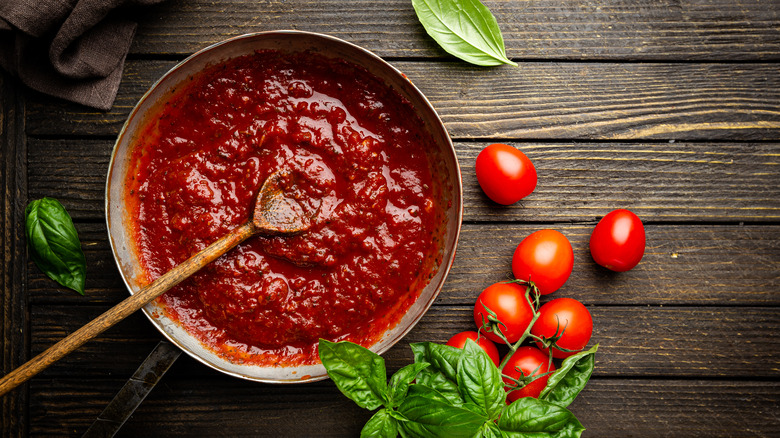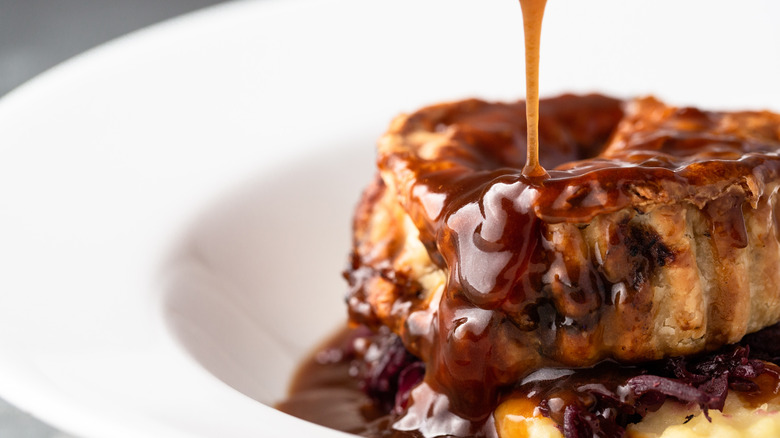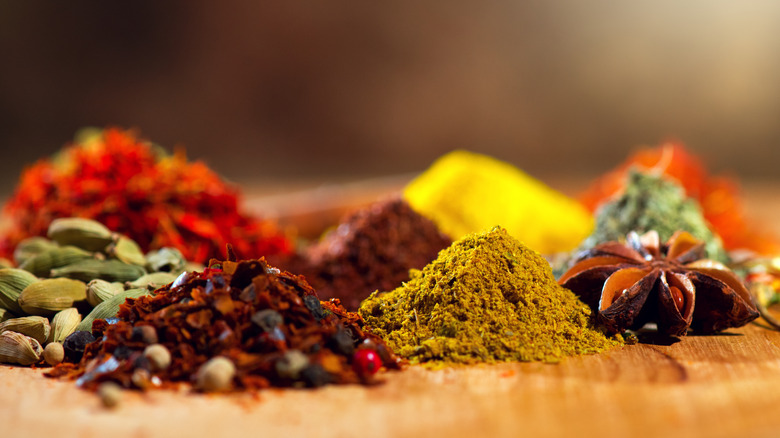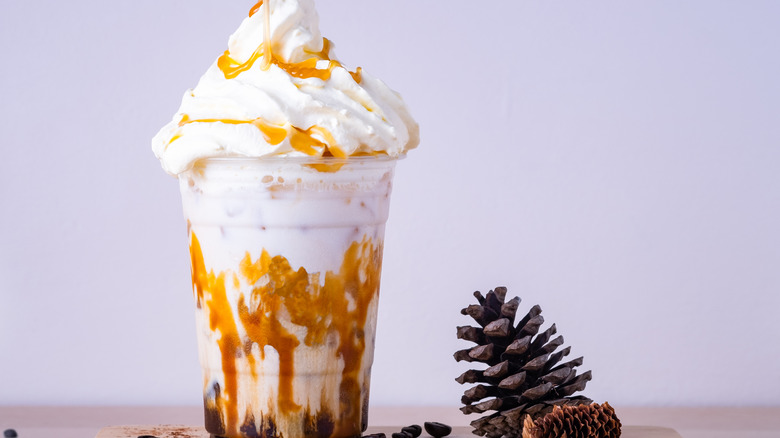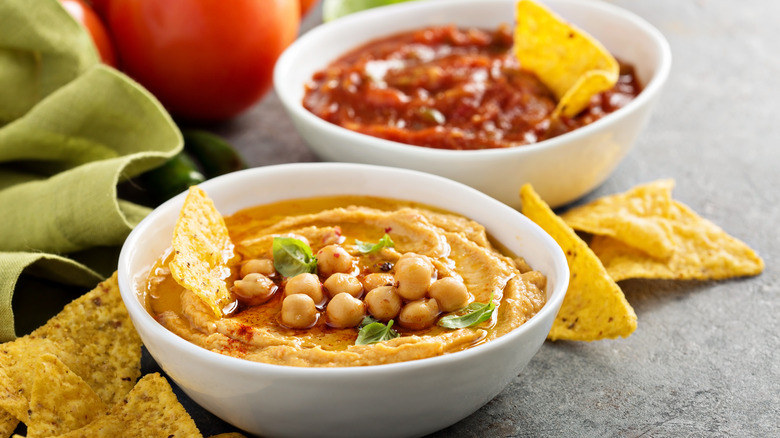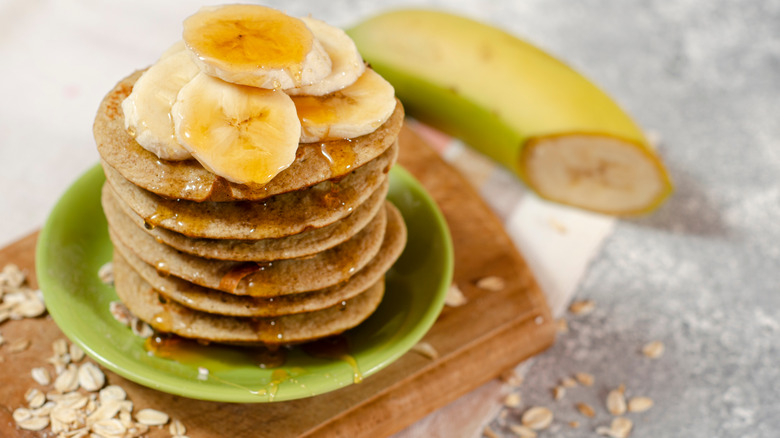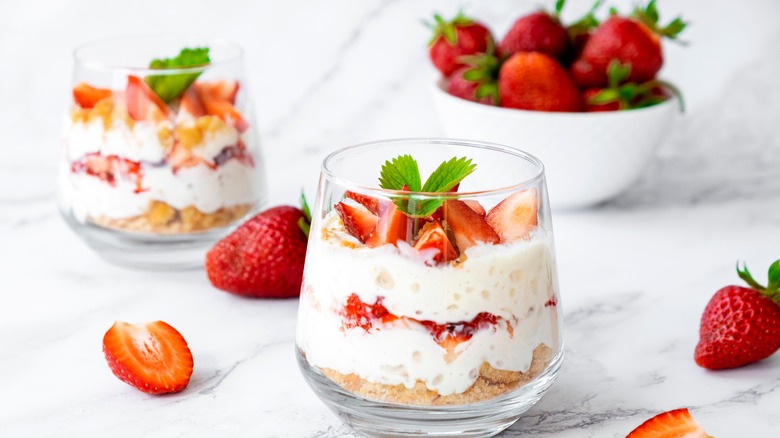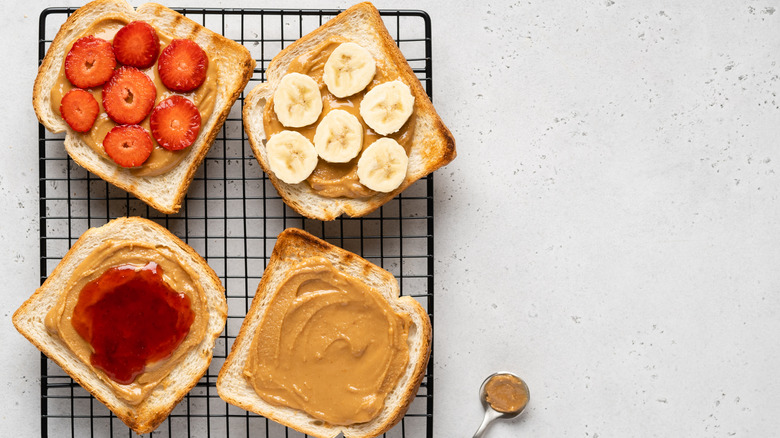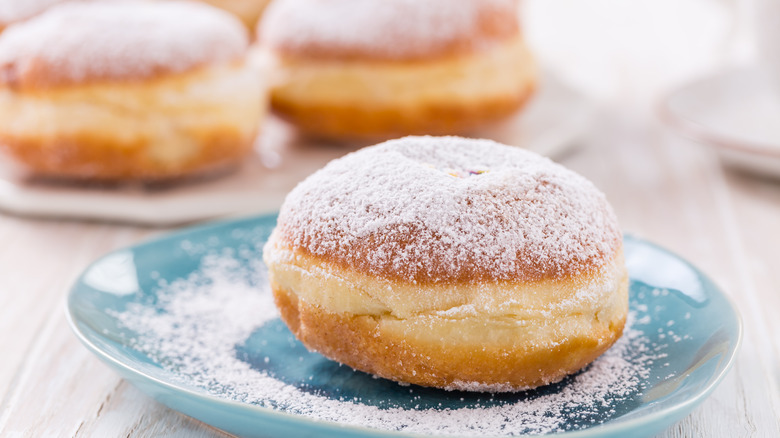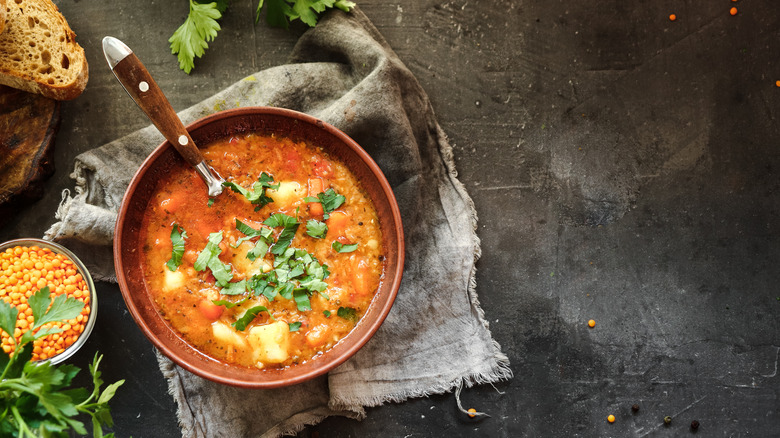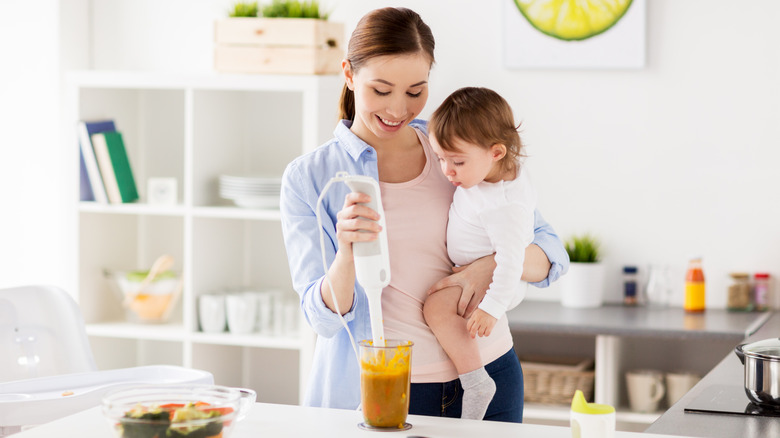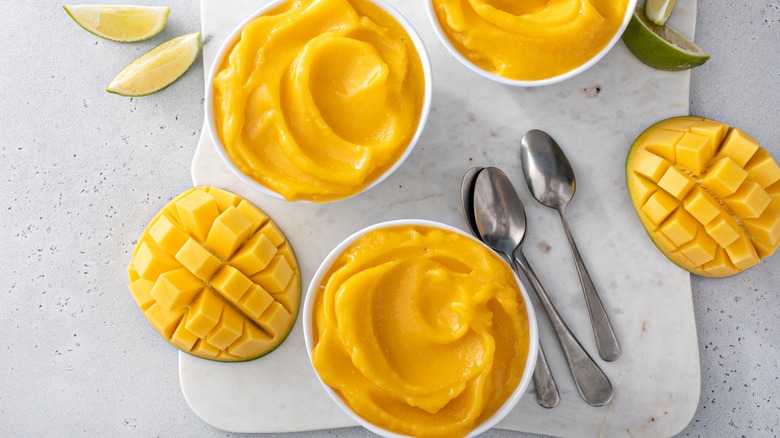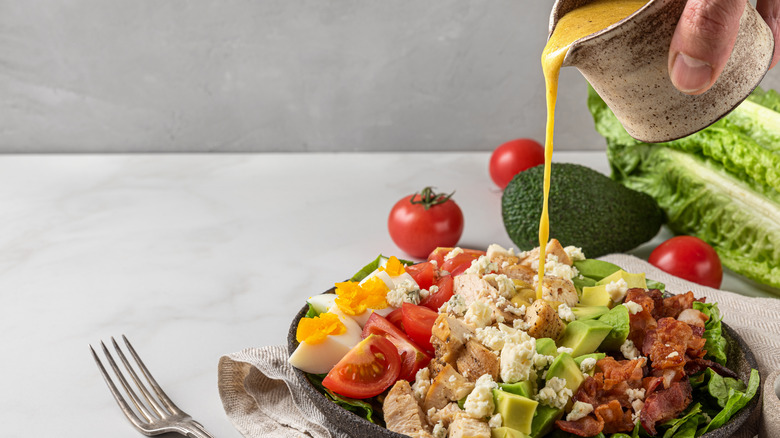Genius Ways You Never Thought To Use Your Blender
Whether you make every meal from scratch or rarely cook, it's a safe bet you have at least one kitchen appliance that sits unused for long periods. It could have been a gift, an impulse buy, or it could be something you thought would be life-changing.
If that gadget is your blender, sitting at the back of a hard-to-reach cabinet, you're missing opportunities to make cooking easier, faster, and more fun. As we try to eat more fruits and veggies, many of us turn to smoothies, but blenders are handy gadgets with more potential. The Association of Home Appliance Manufacturers (AHAM) reports that nine out of ten American households have a blender. Many surveyed listed health and nutrition goals as top reasons to own one.
Don't misunderstand: smoothies are a delicious and nutritious way to prioritize healthy choices. Smoothie drinkers should continue blending away. But if you want to discover all the tricks your blender has up its sleeve, get ready to wow your tastebuds with more options.
Pasta sauce with fresh tomatoes
Using a jar of pasta sauce can be an easy dinner shortcut, but everyone should know how to make homemade tomato sauce, and using canned tomatoes makes it super simple. If you have a bit more time, fresh tomatoes will elevate your spaghetti dinner to a new level. Whether you have a bunch of tomatoes from the garden or buy them at the store, you'll find that using fresh tomatoes makes a sauce worthy of an Italian grandma.
Homemade tomato sauce is an excellent source of lycopene, a carotenoid that our bodies need to fight disease. Fresh tomato sauce allows you to control the final product's ingredients, texture, and thickness in a way that processed pasta sauces can't match.
For a deep, rich sauce, roast tomatoes, onions, and garlic with olive oil, then pop them into the blender to taste. Season, simmer, and serve the best pasta you've ever had. Julia Child was also a fan of roasted tomato sauce, but she preferred to blister her veggies on a hot griddle before blending them smooth and adding them to reduced cream. No matter which recipe you choose, your blender will make it a snap to prepare.
Gravy
If you've ever had lumpy gravy, you know it's a disaster. Lumps happen; rushing the gravy-making process, not whisking enough, or using too much flour can leave you with a thick, gluey mess that can wreck the finest meal. The good news is your blender will rescue lumpy gravy in a few seconds. Just pour it in and blend out the lumps; nobody will be the wiser, and you won't waste half your gravy trying to strain them out.
Want a new way to love gravy? Try roasting onions with olive oil, then blending them with stock and cornstarch for a delicious blender onion gravy. Traditionally served over meat, onion gravy is delicious with vegetarian or vegan dishes as long as you make it with vegetable stock. Once you try it, you'll find it complements practically any dish.
Devotees of nutritional yeast know that this savory sprinkle adds flavor, boosts vitamins, fiber, and amino acids to foods, and serves as a beloved cheese substitute. You can whip up a nutritious vegan gravy in the blender by combining nutritional yeast, veggie broth, and other simple ingredients before simmering it to reduce and thicken.
Ground spices
While many people buy spices ground or powdered, some cooks prefer to buy certain ones whole and grind them just before use, such as cinnamon, nutmeg, cloves, cumin, and cardamom. Spices can grow stale as they age, and though heat can perk them up again, whole spices provide more flavor and longer shelf life. The hardest part of this method is figuring out the best way to grind the spices finely for cooking, since biting into tricky bits takes the fun out of almost any meal.
Many cooks turn to their coffee grinder to pulverize cinnamon or cloves to a powder. Still, unless you buy a second coffee grinder dedicated to this task, your morning brew could end up tasting decidedly odd. Blenders are washable while submerging your coffee grinder in water is a no-no.
Remember to ensure the blender's inside is completely dry before grinding spices, since any moisture will make the spices clump up and stick to the jar instead of becoming a fine powder. Pulsing the spices on a lower setting to check the consistency will give better results than overprocessing them. Still, following these tips, you can turn cinnamon sticks into perfectly powdered cinnamon in seconds flat.
Frozen coffee drinks or cocktails
Fancy drinks can turn any day fabulous, whether you're expecting guests or want a sweet treat. There's nothing like frozen coffee drinks or cocktails, but if you head to a bar or coffeehouse to get your fix, your wallet will take a hit. Marking up drinks is a well-known profit maximizer at many restaurants, from Starbucks to your local pub.
The good news is you can make great-tasting frozen delights in your kitchen for a fraction of the cost with a blender and a few ingredients. If dessert-like coffee drinks are your jam, make ice cubes with leftover coffee or espresso (or a batch you brewed to make ice, we won't judge) so your blended drinks don't get watered down. Once you have a stash of coffee ice, let your imagination run wild with your choice of milk and flavorings (caramel sauce is delicious!), and dress up the result with whipped cream and shaved chocolate on top.
Would you prefer a decadent drink that's spiked? Whether you want classic frozen margaritas for Taco Tuesday, or you're in the mood for a beachy cocktail on a hot afternoon, it's easy to whip up delicious drinks with your blender. Using frozen fruit instead of ice adds tons of flavor, and hey, doesn't that make it a smoothie? Sounds like a win-win to us.
Homemade dips
Everyone loves a good dip, and though you can buy prepared dips of any kind, making them at home in your blender is a no-brainer. Although a jar of salsa probably won't break the bank, it will taste fresher and have more nutrients if you make it from scratch. You can also customize ingredients and spice levels for your taste and impress your friends with your mad cooking skills, so why wouldn't you make your dips rather than buy them?
Some dips, like ranch or sour cream and onion, only need mixing to reach perfection, but other classics take prep work before serving. Hummus can be whipped up in a snap using your blender and simple ingredients: chickpeas, tahini, olive oil, garlic, lemon, and salt. It's a healthful snack. Simply serve it with pita and raw veggies, or spread it on a sandwich.
If Mexican is on the menu, salsa is a must-have. Roasting seasoned vegetables with chili peppers and pulsing them in the blender to your desired level of chunkiness is as easy as it gets, and the results will make you swear off jarred salsa. Black bean dip is easy, it can be adapted to suit any variety of beans you have on hand, and the spiciness is easy to customize to your preference. Serve it with chips right after blending or hot with cheese melted on top. It stores well and can serve as the key ingredient to other meals, like quesadillas, nachos, or enchiladas.
Healthier pancakes
Most of us love pancakes for breakfast (or dinner!) but might feel guilty about eating these nutritionally-bereft carb cakes covered in butter and syrup. Luckily, through the magic of internet crazes, more of us are making 3-ingredient pancakes, a healthier breakfast choice. These pancakes are made with bananas, oatmeal, and milk and contain way more fiber, protein, vitamins, and minerals than classic pancakes.
Using the blender to make the batter is quick and breaks down the texture of the oats, just in case you have an oatmeal hater at your table. Remember, these pancakes are different from pancakes made with flour. Banana oat pancakes have no gluten, so blending them up won't hurt them at all; the texture is better when they're smooth. Don't get confused because your mom taught you to leave lumps in your pancake batter; overmixed flour pancakes stay flat because the flour's gluten develops, so Mom's advice was suitable for those pancakes.
You can pour them right from the blender, making cleanup a breeze, and serve them with fruit, peanut butter, Nutella, or plain old butter and maple syrup. No matter how you make them, healthy pancakes never tasted so good.
Whipped cream
Homemade whipped cream makes any treat decadent and it is surprisingly easy to make. Whether you enjoy ice cream sundaes, pie, hot chocolate, or a Starbucks-inspired caramel Frappuccino, whipped cream will improve the experience. The ingredients for whipped cream are simple: heavy cream, sugar, and a splash of vanilla, but you can also add cocoa, instant coffee, or other flavor extracts to complement any dessert.
Whipped cream forms peaks when air is incorporated, and is usually made by hand or with a mixer, but it's easy to turn cream into beautiful clouds in the blender. Plus you'll have just one jar to wash, and won't waste even a bit of whipped cream when you add it to your milkshake.
Making whipped cream in the blender is a cinch; add your ingredients and blend on low speed to mix them, then let the cream start to thicken. The timing varies according to your blender, so watch it carefully. When the cream looks thicker, you can increase the speed setting, which allows the blender to incorporate more air into the cream. Check the consistency every few seconds so you don't over-mix; sweetened butter is the last thing you want. It will take less than a minute to make whipped cream in your blender, and you'll wonder why you've never tried it before.
Homemade nut butter
Nuts are a terrific source of protein, fiber, antioxidants, vitamins, and minerals (via Healthline). Although premade nut butter is often loaded with preservatives, salt, and sugar, making homemade nut butter in a blender will feel as simple as eating a handful of peanuts. Of course, you can also customize homemade nut butter with honey, sea salt, cinnamon, or a ribbon of chocolate – whichever way you choose to make it, you control each ingredient.
Though we usually think of Nutella as more of a dessert than nut butter, it qualifies as one since it's made from hazelnuts. However, major controversy popped up around Nutella's claims of wholesome nutrition, and now we know it has lots of sugar and fat in a two-tablespoon serving. Don't despair if you adore Nutella on toast or as a dip for fruit, though – you can easily make your own with hazelnuts, dark chocolate, and sea salt.
Making nut butter in the blender is as easy as pouring nuts into the blender and blitzing them. Start slow, allowing the nuts to form a sand-like texture. Scrape down the sides occasionally; the nuts will smooth into a thickened paste. You can add a pinch of salt, a little oil, or some sweetener, but it isn't necessary. Whether you crave cashew butter, almond butter, or peanut butter – the process is the same, and the results will make the perfect sandwich.
Powdered sugar
If you've ever spent time making a beautiful cake and then, as you start to gather ingredients for the frosting, found that you're out of powdered sugar, you're not alone. Powdered sugar, also known as confectioner's sugar, is an easily forgotten pantry item. It doesn't tend to feature on regular grocery lists since it is used for dusting over sweet treats, in glazes, and for fluffy buttercream frosting. Since we often buy it in small bags and buttercream frosting recipes call for large amounts of powdered sugar, it's easy to run out and forget to restock.
Great news for the forgetful: all you need to replenish your powdered sugar is regular table sugar and a bit of cornstarch. The cornstarch is essential because it keeps the finely ground sugar from caking up and adds stability to frostings and glazes, too; use a tablespoon of cornstarch for every cup of sugar.
Once you gather the ingredients, powdered sugar is just a moment away. Blend the sugar and cornstarch on high for 30 seconds and check the consistency; blend longer if necessary. Continue your cake-making adventure, and remember, any extra sugar can be stored in a jar or airtight container till next time.
Hearty soups
A bowl of hearty soup can brighten your outlook during frightful weather. When it's cold outside, thick, creamy soups are always popular. Of course, creamed soups serve up a lot of fat and calories, offsetting our best intentions, but if you have a blender, you can substitute healthful ingredients like beans or potatoes for heavy cream. Trust us, it's the best of both worlds.
You can replace cream in any recipe with low-fat milk (or milk substitute) and add potatoes or white beans, puréed smooth in the blender. Whisk the purée into the soup, and you aren't likely to notice a difference in flavor while enjoying the benefit of extra fiber, vitamins, and minerals – and slashing fat and calories. Variations on potato soup are often made with plenty of cream and cheese, but if you purée potato cauliflower soup and make it with non-dairy milk, you'll have an elegant vegan meal on the table in under an hour.
Cuban recipes, such as Red Beans Soup, traditionally cook dried beans with sofrito, a puréed mixture of onions and green pepper that is sautéed with garlic and tomato sauce. The beans and sofrito are simmered till they thicken, but cooks often purée some of the beans for an even thicker texture. This soup season, play around with your favorite recipes to see how your blender can make soups even more nutritious and filling.
Fresh baby food
Every parent wants the best for their child, especially when it's time to feed the baby their first solids. There's nothing wrong with commercial baby foods, but making meals at home in the blender is painless and lets you control what your baby eats, avoiding added sugar, salt, and preservatives. You can introduce your baby to foods that might not come in jars at the store, expanding their tastebuds beyond applesauce and rice cereal. Finally, it's easier on the wallet than commercial baby food, and you can store tiny portions in the freezer with less waste.
You can make homemade baby food in large batches or while cooking family meals. For example, when you make butternut squash for dinner, remove some for baby food before adding any seasoning. Pop it in the blender with water, breast milk, or formula, and purée to the desired consistency. Homemade baby food may be stored in small containers in the fridge, but freezing it in ice cube trays or small dollops on a cookie sheet and then storing portions in a freezer-safe bag means you can thaw and serve as needed with no waste.
Little ones need many nutrients in the early years, when baby brain development and growth are progressing faster than at any other time of life. Making baby food in your blender allows you to feed your child a large variety of healthy foods while cultivating their love of homemade food from the start.
Frozen desserts
Is there ever a wrong time for ice cream or another frozen treat? If you don't own an ice cream machine, you can whip up delicious concoctions by blending a few ingredients and letting your freezer do the work. Next time you crave ice cream, blend heavy cream and condensed milk with your choice of flavoring, then freeze for a few hours in a metal loaf pan. The blender mimics churning and adds lots of air to the mixture, resulting in the rich creaminess everyone loves.
Sorbet is just the ticket if you want a light, fruity dessert. Blend any combination of fresh or frozen fruit, adding juice, sweetener, or herbs to taste, and freeze till solid. The secret to sorbet is to blend it again after it freezes, giving you sorbet's smooth texture and opaque look. Or, for a light, rough texture, use it to make granita, a shaved ice treat from Sicily. Scrape the sorbet base into dishes with a fork and enjoy.
If you're vegan or prefer a luscious, healthy dessert, baked sweet potato blended with coconut milk and chocolate makes a great vegan ice cream you have to taste to believe. We know it might raise eyebrows, but trust us, the sweet potato creates body while the chocolate completely masks its flavor. Not all desserts make us feel pious, but eating sweet potato-based ice cream sure does.
Salad dressing
Salads are nutritional powerhouses; a massive plate of greens and veggies topped with lean protein, some avocado, and maybe a sprinkle of nuts or cheese makes a healthful and filling meal. But we all know that the dressing can ruin your best nutrition goals, making that salad a diet disaster by piling on fat, calories, preservatives, salt, and sugar.
Good news: with some know-how, you can make a delicious salad dressing in a blender with no oil and even nutritious ingredients that add extra protein, vitamins, and fiber to the salad. People love oil-based dressing for the silky mouthfeel and the way the dressing coats the greens, but you can use puréed nuts, avocado, flax seeds, tahini, hummus, and even beans as a base for a dressing that mimics oil and is much better for you.
If you aren't ready to go oil-free and want a homemade vinaigrette, you should still consider using a blender to emulsify the dressing. Whisking or shaking a jar of dressing is fine, but it separates quickly, while the blender's power works with any spices in the recipe to stabilize the mixture. If you want a healthier alternative to processed salad dressing, using the blender to emulsify will be a closer mimic of store-bought brands.
